Making Teaching & Learning Easier教研讲座[上学期]
文档属性
| 名称 | Making Teaching & Learning Easier教研讲座[上学期] | 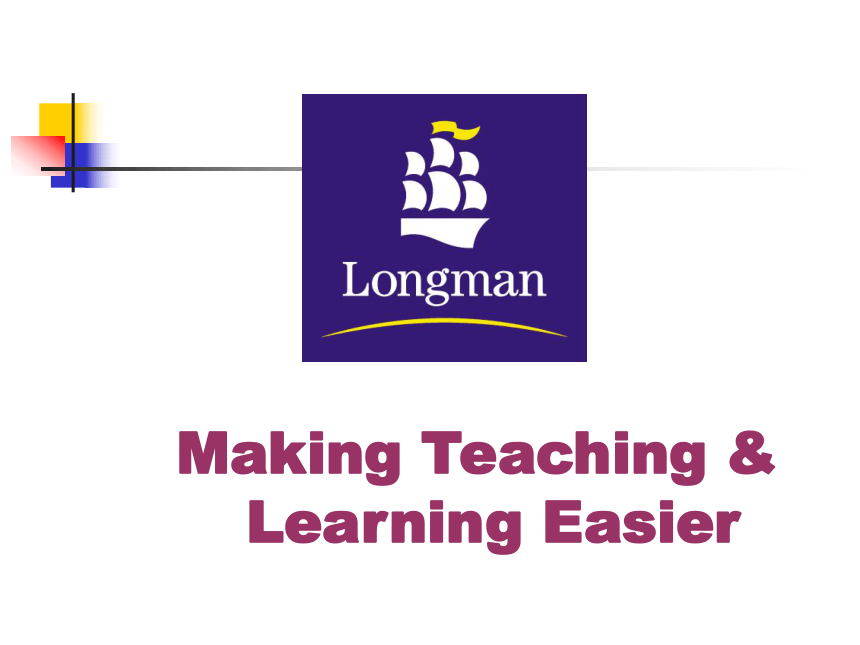 | |
| 格式 | rar | ||
| 文件大小 | 99.5KB | ||
| 资源类型 | 教案 | ||
| 版本资源 | 北师大版 | ||
| 科目 | 英语 | ||
| 更新时间 | 2008-02-12 21:57:00 | ||
图片预览

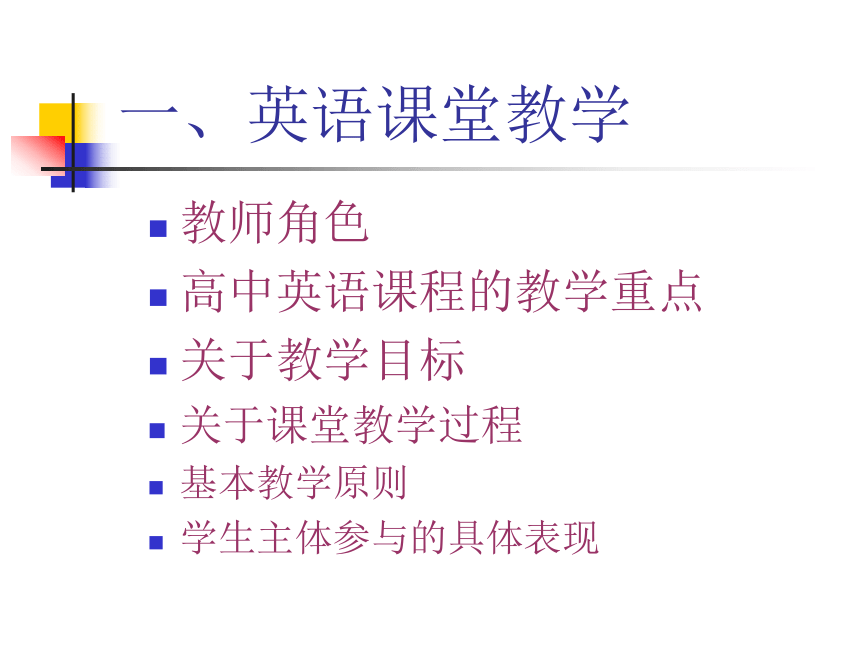
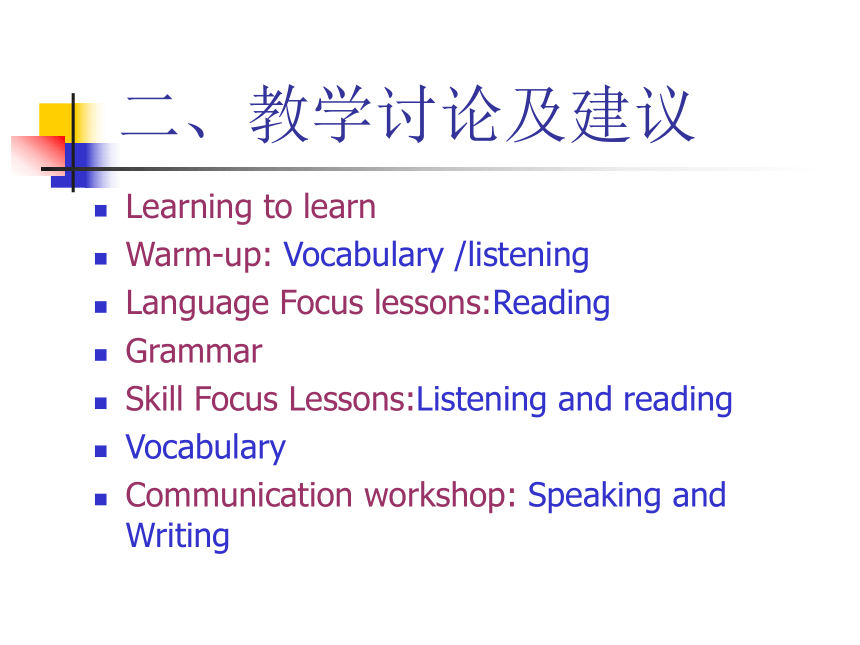

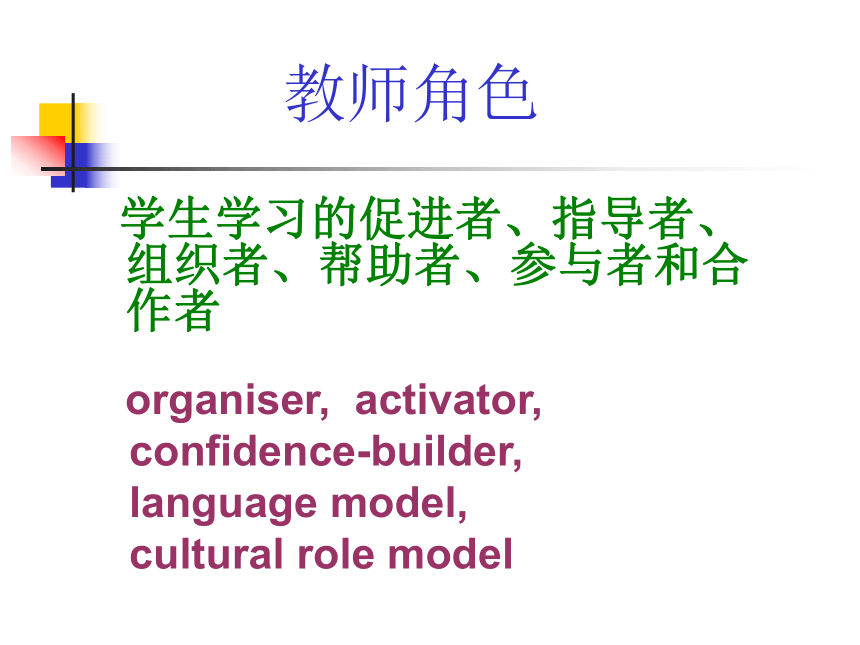
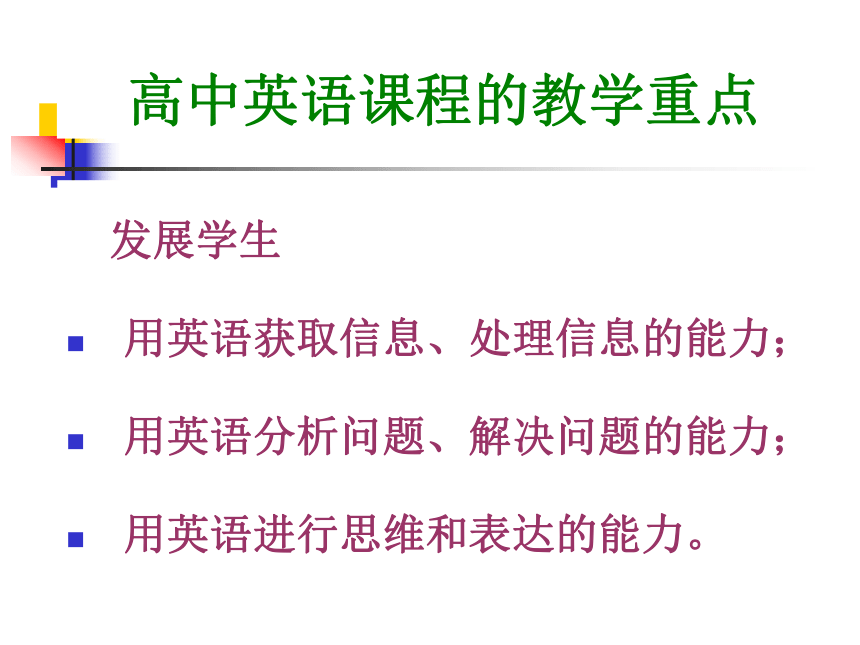
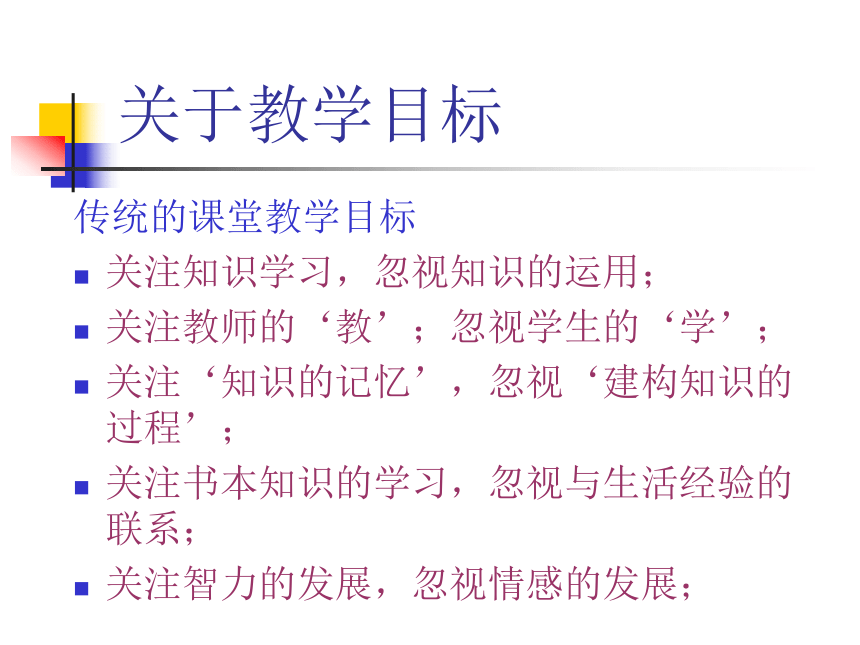
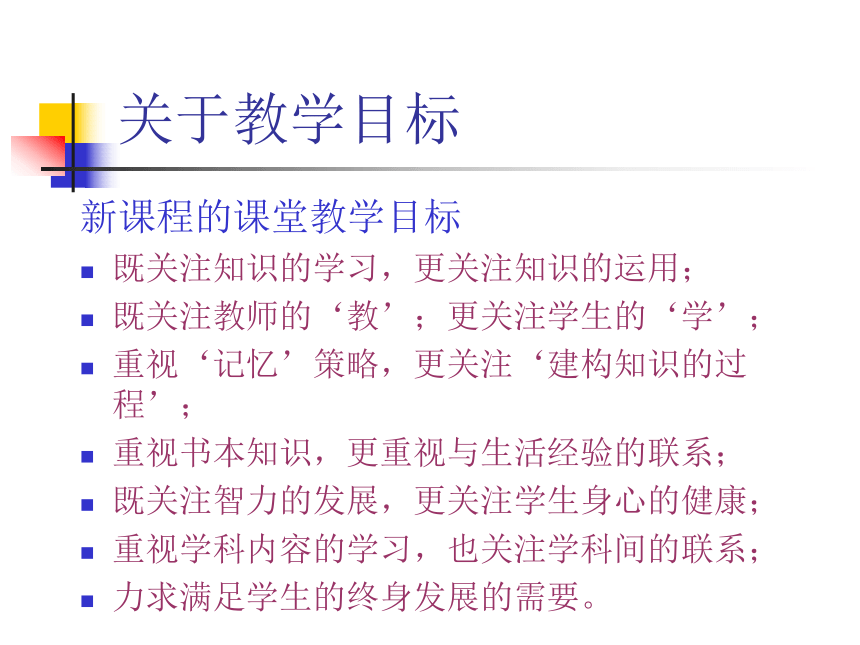
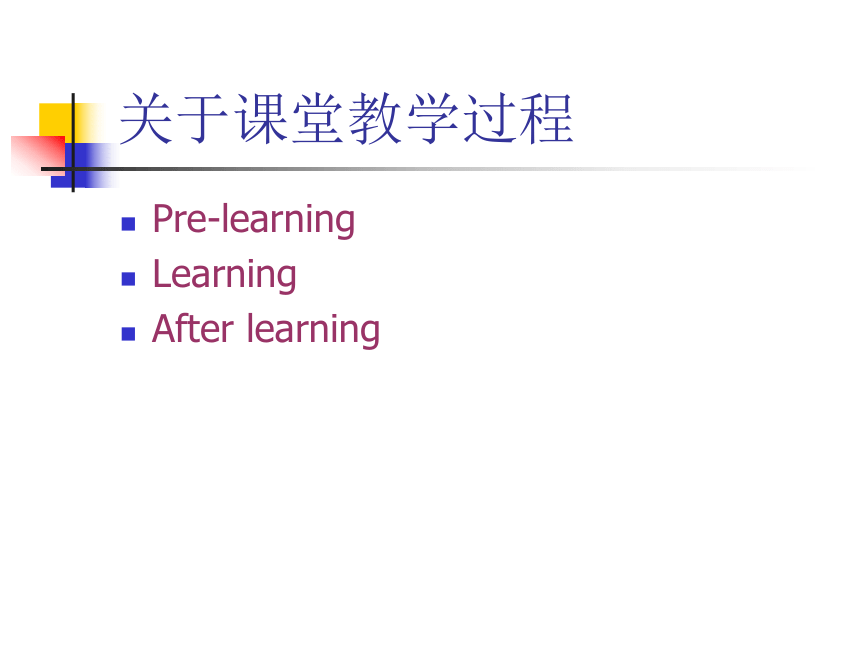
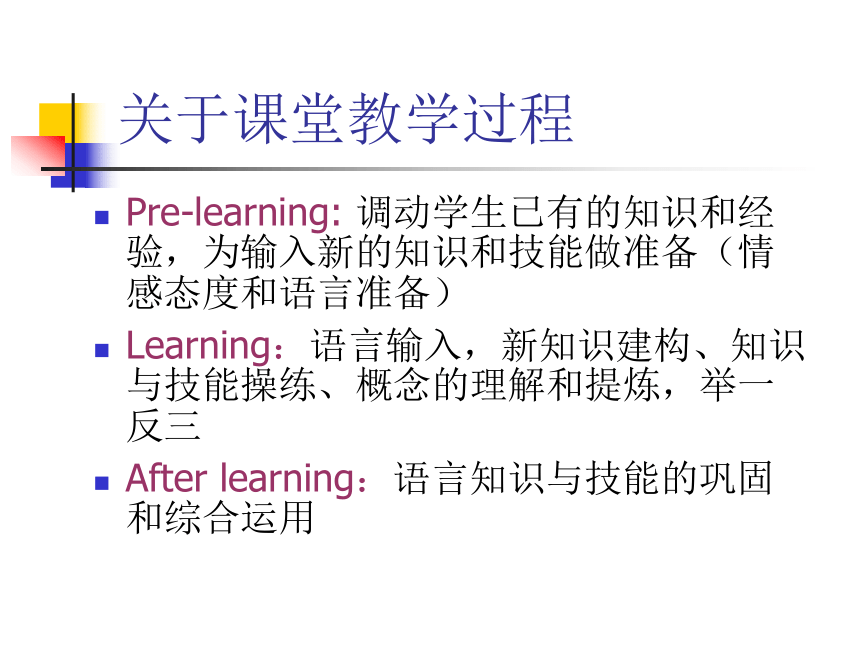
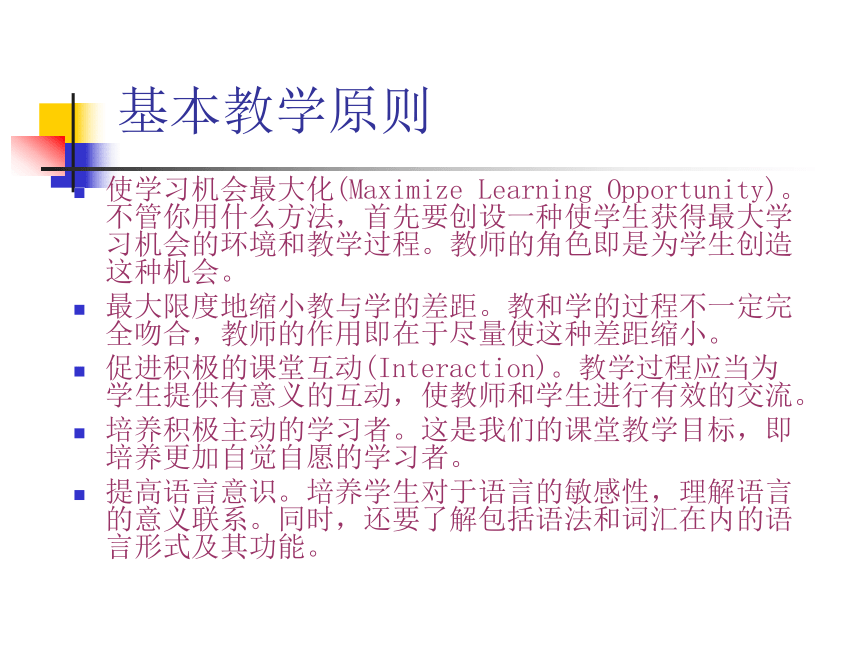
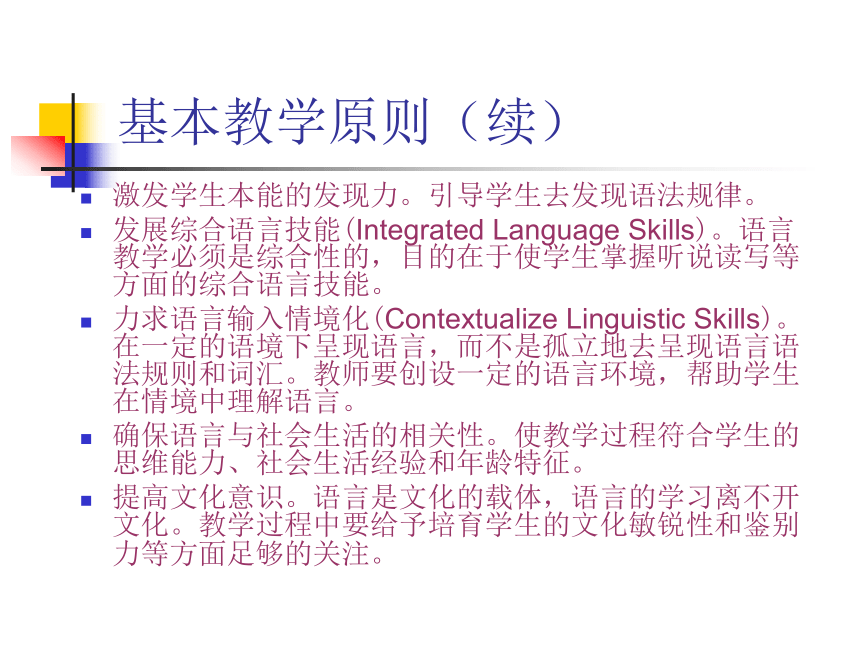
文档简介
课件76张PPT。Making Teaching & Learning Easier一、英语课堂教学教师角色
高中英语课程的教学重点
关于教学目标
关于课堂教学过程
基本教学原则
学生主体参与的具体表现
二、教学讨论及建议Learning to learn
Warm-up: Vocabulary /listening
Language Focus lessons:Reading
Grammar
Skill Focus Lessons:Listening and reading
Vocabulary
Communication workshop: Speaking and Writing
三、教学课例观摩与探讨广东中山一中 戴一鸣
广东顺德李兆基中学 黄虹波
教师角色
学生学习的促进者、指导者、组织者、帮助者、参与者和合作者
organiser, activator,
confidence-builder,
language model,
cultural role model
高中英语课程的教学重点 发展学生
用英语获取信息、处理信息的能力;
用英语分析问题、解决问题的能力;
用英语进行思维和表达的能力。关于教学目标传统的课堂教学目标
关注知识学习,忽视知识的运用;
关注教师的‘教’;忽视学生的‘学’;
关注‘知识的记忆’,忽视‘建构知识的过程’;
关注书本知识的学习,忽视与生活经验的联系;
关注智力的发展,忽视情感的发展;
关于教学目标新课程的课堂教学目标
既关注知识的学习,更关注知识的运用;
既关注教师的‘教’;更关注学生的‘学’;
重视‘记忆’策略,更关注‘建构知识的过程’;
重视书本知识,更重视与生活经验的联系;
既关注智力的发展,更关注学生身心的健康;
重视学科内容的学习,也关注学科间的联系;
力求满足学生的终身发展的需要。
关于课堂教学过程Pre-learning
Learning
After learning关于课堂教学过程Pre-learning: 调动学生已有的知识和经验,为输入新的知识和技能做准备(情感态度和语言准备)
Learning:语言输入,新知识建构、知识与技能操练、概念的理解和提炼,举一反三
After learning:语言知识与技能的巩固和综合运用基本教学原则使学习机会最大化(Maximize Learning Opportunity)。不管你用什么方法,首先要创设一种使学生获得最大学习机会的环境和教学过程。教师的角色即是为学生创造这种机会。
最大限度地缩小教与学的差距。教和学的过程不一定完全吻合,教师的作用即在于尽量使这种差距缩小。
促进积极的课堂互动(Interaction)。教学过程应当为学生提供有意义的互动,使教师和学生进行有效的交流。
培养积极主动的学习者。这是我们的课堂教学目标,即培养更加自觉自愿的学习者。
提高语言意识。培养学生对于语言的敏感性,理解语言的意义联系。同时,还要了解包括语法和词汇在内的语言形式及其功能。
基本教学原则(续)激发学生本能的发现力。引导学生去发现语法规律。
发展综合语言技能(Integrated Language Skills)。语言教学必须是综合性的,目的在于使学生掌握听说读写等方面的综合语言技能。
力求语言输入情境化(Contextualize Linguistic Skills)。在一定的语境下呈现语言,而不是孤立地去呈现语言语法规则和词汇。教师要创设一定的语言环境,帮助学生在情境中理解语言。
确保语言与社会生活的相关性。使教学过程符合学生的思维能力、社会生活经验和年龄特征。
提高文化意识。语言是文化的载体,语言的学习离不开文化。教学过程中要给予培育学生的文化敏锐性和鉴别力等方面足够的关注。
学生主体参与的具体表现教师角色的转变
学生主动、积极,自信
课堂气氛民主、平等、活跃
有效调动学生已有知识和经验
学生发现新知识(如:语言的规律,表达的方式)
学生积极思考,从不知到知,体现建构过程
学生有表达个人的观点、意见或情感的机会
学生有自主提问的动机和机会
活动设计从学生的兴趣和经验出发
教师鼓励、尊重、发展学生的见解和观点
学生主体参与的具体表现教师是积极的倾听者
教师与学生交流学习的目标和达标的要求
教师允许学生出错,适时帮助修正
教师与学生有真实的交流机会
教师创造机会让学生反思和评价自己的学习
教师给予学生进行选择的机会
教师提供师生、生生互动的机会
教学渗透与其他学科知识的联系
教师提供学生用英语做事情的机会
教师与学生交流和讨论情感……
grammarvocabularylisteningReadingWarm-upProjectLearning to learnLiterature spotLanguage powerCulture cornerBulletin boardUnit DiaryLanguage focusSkill focusGuided speaking & writing practiceUnit 1Unit 2Unit 3Communication work shopLesson 1
Lesson 2
Lesson 3
Lesson 4 模块Writing Help
Grammar Summary
Notes to the texts
Word ListSuggested class timesLearning to learn (2 periods)
Each unit (12 periods)
Warm-up (20 minutes or so)
Four lessons (8 periods)
Communication Workshop (2 periods)
Culture Corner and Bulletin Board (homework)
Unit Diary (20 minutes)
Language Power and Review (1 period)
Important feature –Learner developmentStudents are encouraged to develop as independent and active learners of English.
These skills and habits will make them better students throughout their educational lives.
Learner developmentSee learner development as investment: organize vocabulary books, used to the self-study features---become more effective students
Self-study features:Learning to learn, Unit objectives, Strategies Boxes, Writing help, Grammar Summary, Mini-Grammar, Notes to the Texts, Focus on Reading/Writing, Word Corner / Tips / Power, Key Word Bank, Check Your Progress
Encourage students to keep learner diaries: What have you done/learned? What problems have you had? What was the most useful parts of the unit
Use the unit objectives.
Time for reflection.
Link self-assessment with your own assessment.
Using Learning to learn To arouse students’ awareness of individual autonomy.
Part A: To get students motivated toward speaking English in class.
Part B: To provide familiarity with the new coursebook and arouse interest.
Part C: To review grammar and encourage record-keeping of new grammar.
Using the warm-up pageIntroducing the unit theme
Building up awareness of skills
Exploring the module theme
Recycling and developing skills
In this unit you will … Stimulates interest in the theme
Brings awareness of what the Ss are learning; helps build confidence
Challenges the SsWhat can you do with Key Words?Work out the meaning with pictures, meaningful contexts, synonyms & Antonyms……
Unit 1 Warm-up
Shepherd---picture
A shepherd’s life is peaceful and relaxing, but a student’s life is usually stressful---(context)
Use the words: I think a student’s life is active, interesting and exciting(positive) but maybe it is stressful sometimes (negative).What can you do with Key Words? Unit 2 Warm-upA: He is always ready to give money or presents to those who need his help.
The boy often causes pain and makes his parents suffer.
She never shouts. She is never angry. She never hurries. She never worries.
B: 31 people have been injured in _______ incidents throughout the day.
Yao Ming is brave, ________ and calm while playing basket ball, He seems a kind and _______ friend in real life, but sometimes a little shy. How I hope he is romantic, too.
C: Christine was trying to make what she said funny and enjoyable, but Peter felt threatened.
Who are your heroes and heroines? Unit 2 Warm-up – Lang Pin ---famous Volleyball player/coach
– Gao Yaojie ---known as an important person against Aids in China
– Nelson Mandela ---brave man, fights for justice, fights against racism. Symbol of hope that things can change
_ Professor Adrian Hall ---hero of “the Day after Tomorrow”, a great character! Try to save the world from the effects of global warming; also try to get his son, Sam
_How to deal with Listening?Build up and develop listening skills:
Unit 1 ---Getting the gist/main idea
Unit 2 --- Predicting
Unit 3 --- Important words
Produce language based on what they have learned: key words and key sentences,etc.
Unit 1 ex 3 and 4
听力主要教学活动举例 Suggestions for ListeningReduce “cassette fear”.
Prepare thoroughly before listening.
Be aware of listening difficulties.
Reduce panic.
Concentrate on task achievement.
Be aware of variety.
Evaluate the text.
Don’t stick to the cassette.
Use Strategies boxes for revision.
Skill Focus Lessons-Listening Before your startPredicting---good listeners are good
predictors. Pictures/Visual aids……
Setting the scene---provide the background information to activate students’ schema, so they will be better prepared to understand what they hear
Listening for the gist---ask ss one or two questions that focus on the main idea of the passage
Listening for specific information---weather report/airport announcement
……
Skill Focus Lessons--- Listen to LearnNo specific response---take the anxiety out of listening
Listen and tick
Listen and sequence---find out the order of the things
Listen and fill Unit 6 ex 3 p.38, Function Files
Listen and guess---oral descriptions of a person, thing, place, action, etc.
Listen to learn : Using the tapescriptIdentify the activity type
Consider how the students would complete the exercise
Find the most suitable use for the tapescript
Skill Focus Lessons--- SpeakingAsking and answering questions
Making dialogues,using functional sentences
Making interviews
Have a telephone conversation
Get prepared for Writing
……
Skill Focus Lessons Example: 6 History MakersDiscussion points
Background knowledge
Providing enough support
Teaching opportunitiesStrategies boxProvides learning tips
Provides real communication in English
Opportunity for comprehension
阅读主要教学活动举例 Skill Focus lessons---Reading Before you start
draw the students’ attention to the topic. Stimulate interests and get ss involved actively in discussing the topic
always be prepared to extend the material
additional vocabulary
additional leading questions
Skill Focus lessons---Reading Before you startPredicting: based on titles, pictures, vocabulary/topics……Unit 1 L.1 p.8, L.4 p.14, Unit 4 L.1 ex 2 p.8, L.3 ex 1 p.12,
Setting the scene: 设置社会文化背景 getting students familiarized with the cultural and social background knowledge relevant to the reading text Unit 1 L.4 p.14, Unit 2 L.4 Christmas
Skimming
Skill Focus Lessons Read to learnChoose your order for the activities
Target your activities according the skills that need to be developed
Consider a variety of options for reading textWhile-reading ActivitiesInformation transfer activities信息转换:图表,标顺序,做笔记,流程图……
transfer information from one form to another ---an be more effectively processed and retained
Activities:
pictures, maps, tables, tree diagrams, cyclic diagrams, flowcharts, chronological sequence, subtitles, note-taking
Reading Comprehension QuestionsQuestions of literal comprehension---answers are directly and explicitly expressed
Questions involving reorganisation or reinterpretation---obtain information from various parts and put it together in a new way
Questions for inferences ---consider what is implied
Questions for evaluation or appreciation ---make judgement about what writer is trying to do and how successful he is in achieving the purpose
Questions for personal response ---answers depend on the reader’s reaction to the textWhile-readingUnderstanding references:
Understanding what referential words
refer to is crucial for comprehension
Making inferences:
“reading between the lines”, requires the reader to use background knowledge in order to infer the implied meaning of the authorWhile-readingScanning P.3 ex 3
Choose titles/topic sentences
p. 22 ex 4, p.29 ex 3
Working out the meaning of words
p.26 ex 2, p.29 ex 5,6,7
……Skill Focus Lessons SpeakingPurpose:
Post-reading tasks should provide the students with opportunities to relate what they have read to what they already know or what they feel. In addition, post-reading tasks should enable students to produce language based on what they learned.
teachers have to be most inventive or imaginative. They have to design tasks which are relevant to the text being studied and appropriate to the students’ level.
ReadingEncouraging guessing and prediction.
Encouraging guessing of meaning.
Encourage inference.
Focus on style.
Develop dictionary skills.
Only focus on key words in texts.
Encourage extensive reading outside the class.
Use Strategies boxes for revision.Language Focus LessonsLanguage input: do tasks on reading and listening texts,only concentrate on the meaning of the text
Grammar Presentation: Focus ss’ attention on the target grammar in the text, then use the examples to work out rules in a guided way, refer to Grammar Summary for further explanation
Practice: carefully graded and get ss to apply the rules they have just discovered
Grammar Presentation and PracticePay attention to both form AND fun_ction
Make use of the Grammar Summaries
Look for teaching points in the practices
What happened? What was the crowd doing?
What were the other team members doing?
What was his mother doing?
What were you doing? Grammar Presentation and PracticePay attention to both form AND fun_ction
Make use of the Grammar Summaries
Look for teaching points in the practices
Explore all options for the practice Language Study Example: p26 Grammar presentation
Ask leading questions to highlight fun_ction of the tense
Reinforce with real life questions when appropriate
GrammarEncourage Individual grammar notes.
Develop reference skills.
Get students to work out grammar rules themselves.
Don’t worry when students say “We’ve done it before!”
Top ten most typical mistakes in the class.
Get students to produce language tests.
Voice your opinion/ Language in useGive students necessary support
Encourage communication Example:Lexical Approach classroom activity The materials in this article aim to achieve the following goals:
General Goals
To develop students’ reading skills
To increase students’ store of lexical chunks
More Specific Goals
To motivate students to read by
providing texts with universally engaging themes
providing activities that allow students to personalise texts
encouraging meaningful and authentic initial reactions to texts
To help students develop skills for independent learning by
providing opportunities to experience lexical chunks in authentic texts
encouraging students to analyse, generalise, research and experiment with lexical chunks
providing students with opportunities to discover chunks for themselves
Before you read1: You are going to read a story about a young teenage boy from England. The boy has upset his parents.
Read these sentences from the story and decide whether you think they come at the beginning, in the middle or at the end of the story.
"I got slapped three times with the sole of her shoe. Three times. That was it. Then she left my room. She never said a word."
2: The story is called Away Day and the first sentence reads, “The only time I ever bunked off school, I was thirteen years old.”
What do you think the story is about? Write down some guesses and share them with other students.As you read1: As you read the story from the point of view of a teenage school boy, try to see pictures of the boy in your mind and decide if the boy deserved the punishment.
After you readReaction
1: Tell a partner, if you think the boy's punishment was appropriate and what you would have done if you were the parents.
2: Think about the following questions:
How do you feel about the boy in the story?
Why do you think the boy went with the twins?
Why do you think the boy's mother reacted in the way she did?
At the beginning of the story the author tells you the twins were always in trouble. Why do you think he tells you that?
Discuss your thoughts about the questions in a small group.
3: Discuss your answers to the following questions with a partner:
In paragraphs 1 and 2, what words tell you the housing estate is poor/working class?
In paragraphs 3 and 4, how do you know the weather is hot and has been hot for some time?
In paragraphs 5 and 6 the boy is becoming more and more frightened. What do you think frightens him?
The boy was punished in the final paragraph. Was it the punishment he expected? Was the punishment effective?
Look at the language1: Look at the lexical chunks below. All the expressions are from the story, Away Day.
For each chunk try to write an equivalent in your language. Are they lexical chunks in your language too?
Tell a partner about the lexical chunks in your language.
Lexical chunks (frozen or fixed)
in the middle of nowhere
I had no idea
Lexical Chunks (semi-frozen or semi-fixed)
She never said a word
I didn’t know where we were going
I didn’t know what we were doing
Look at the language adjective plus noun collocations
2: What other nouns can you use after the adjective ‘shiny new’? e.g. shiny new shoes shiny new bike
3: What other nouns can you use after the adjective ‘broken’? e.g. broken heart broken window
What nouns can’t you use after ‘broken’? e.g. broken house
Examples of verb plus noun collocations
I didn’t do my homework. (do / homework)
They were always in trouble with the teachers. (be / trouble)
4: Underline the weakest verb and noun collocation.
Example: Exam take / pass / fail / study for / sit / revise
homework do / forget / lose / prepare / finish / hand in
trouble be in / expect / make / discover / get into / ask for
5. Read the story again and make a list of collocations you think are useful to know.
Using English 1: Think of a time you were punished by your parents.
2: Tell a partner why you were punished and how you were punished.
3: With your partner decide if the punishment was fair.
4: Write about the time you were punished for other students in your class to read.
OR
1: Think about a time you helped a friend.
2: Tell a partner who your friend was and how you helped your friend.
3: Write about the time you helped your friend for another friend to read.
Teaching VocabularyWays of presenting vocabulary:
Try to provide a visual or physical demonstration whenever possible, using pictures, photos, video clips, mime or gestures to show meaning.
Provide a verbal context to demonstrate meaning. Then ask students to tell the meaning first before it is offered by the teacher.
Use synonyms or antonyms to explain meanings
Use lexical sets or hyponyms to show relations of words and their meanings, e.g. cook: fry, boil, bake, grill, etc.
Translate and exemplify, especially with technical words or words with abstract meaning.Teaching VocabularyUse word formation rules and common affixes to build new lexical knowledge on what is already known.
Create and providing different contexts for introducing new words.
e.g. grumble
Some people grumble about everything. For example, they grumble about the weather. If it is sunny, they say it is too hot. If it is cool, they say it is too cold. They are never happy with the weather. They always grumble about the weather
Think about the context in real life where the word might be used. Relate newly learned language to students’ real life to promote high motivation.Teaching VocabularyWays for consolidating vocabulary
Using word series: lifestyle adjectives
Finding synonyms and antonyms (p.68), collocation (teaching collocation is believed to be a more effective way of vocabulary learning than teaching one single word at a time.),
Categories---grouping words into different categories: Key word banks in Language Power
Using word net-work/spiders:
Word corner in Language Power
Teaching VocabularyDeveloping vocabulary learning strategies
Review regularly
Guess meaning from context
Organize vocabulary effectively
Use learned vocabulary
Use a dictionary
Creating vocabulary notebooks
Manage strategy use
Teaching VocabularyFocus on the strategies for learning vocabulary;
Encourage students to guess meaning from context;
Stress the importance of phrases, collocations, word building, word family, etc.;
Encourage students to select vocabulary to remember;
Encourage students to use--- but not overuse--- a dictionary;
Encourage students to keep a vocabulary book or a key word bank, and Use vocabulary books as fillers.
Communication WorkshopSpeaking:
Before you start:Listening-as an example; Speaking strategies
Stages for the speaking activity
Talkback
Communication Workshop Example: p45 surprise, repetition Informal expressions
Use the model as guide NOT script to memorise
Have fun with expressive expressions!
口语主要教学活动举例 Speaking Example: p25 no 7Large reading input
Students need to be guided
Encourage communication
Speaking StrategiesWorking in groups
Preparation for speaking
Asking for repetition
Ways of expressing yourself fluently
Interacting
Dealing with mistakes
Suggestions for SpeakingBefore you start.
Give preparation time.
Encourage individual practice.
Encourage interactive communication.
Reward effort and participation in speaking activities.
Give marks for oral performance.
Only correct afterwards.
Get students to make a list of difficult words to pronounce.Communication WorkshopWriting
Before you start: Read a model and discuss its structure
Stages
Talkback写作主要教学活动举例 写作主要教学活动举例 Writing StrategiesBrainstorming ideas
(using questions/timelines/networks)
Audience awareness
Paragraph planning (using diagrams)
Drafting (using useful vocabulary and linking words)
Checking (content/grammar/ spelling)
Self and peer assessmentSuggestions for WritingFamiliarise students with the Writing Help.
Try out some written tasks in pairs/groups.
Make criteria clear.
Always make sure that students know why they are writing and who they are writing to.
Emphasise the importance of the planning stage.
Make sure students check their writing.
Make sure that compositions are read.
Use correction codes.
Give feedback about the coherence (organization) and cohesion (e.g. linking/punctuation) of students’ texts and only on accuracy.
Focus on style. Project Example: p49 Make a living history museum Project is based on real life
Project teaches study skills
Integrated language
Useful phrases:in my home town there was…
when I was growing up..
we used to …
we had many …
we never had any …
where was plenty of …
there weren’t many …
…is still the same
… is very different now
联系我们曹瑞珍 王 源
北京师范大学出版社
010-58807669
bnupress@263.net
Thank you!bnupress@263.net
高中英语课程的教学重点
关于教学目标
关于课堂教学过程
基本教学原则
学生主体参与的具体表现
二、教学讨论及建议Learning to learn
Warm-up: Vocabulary /listening
Language Focus lessons:Reading
Grammar
Skill Focus Lessons:Listening and reading
Vocabulary
Communication workshop: Speaking and Writing
三、教学课例观摩与探讨广东中山一中 戴一鸣
广东顺德李兆基中学 黄虹波
教师角色
学生学习的促进者、指导者、组织者、帮助者、参与者和合作者
organiser, activator,
confidence-builder,
language model,
cultural role model
高中英语课程的教学重点 发展学生
用英语获取信息、处理信息的能力;
用英语分析问题、解决问题的能力;
用英语进行思维和表达的能力。关于教学目标传统的课堂教学目标
关注知识学习,忽视知识的运用;
关注教师的‘教’;忽视学生的‘学’;
关注‘知识的记忆’,忽视‘建构知识的过程’;
关注书本知识的学习,忽视与生活经验的联系;
关注智力的发展,忽视情感的发展;
关于教学目标新课程的课堂教学目标
既关注知识的学习,更关注知识的运用;
既关注教师的‘教’;更关注学生的‘学’;
重视‘记忆’策略,更关注‘建构知识的过程’;
重视书本知识,更重视与生活经验的联系;
既关注智力的发展,更关注学生身心的健康;
重视学科内容的学习,也关注学科间的联系;
力求满足学生的终身发展的需要。
关于课堂教学过程Pre-learning
Learning
After learning关于课堂教学过程Pre-learning: 调动学生已有的知识和经验,为输入新的知识和技能做准备(情感态度和语言准备)
Learning:语言输入,新知识建构、知识与技能操练、概念的理解和提炼,举一反三
After learning:语言知识与技能的巩固和综合运用基本教学原则使学习机会最大化(Maximize Learning Opportunity)。不管你用什么方法,首先要创设一种使学生获得最大学习机会的环境和教学过程。教师的角色即是为学生创造这种机会。
最大限度地缩小教与学的差距。教和学的过程不一定完全吻合,教师的作用即在于尽量使这种差距缩小。
促进积极的课堂互动(Interaction)。教学过程应当为学生提供有意义的互动,使教师和学生进行有效的交流。
培养积极主动的学习者。这是我们的课堂教学目标,即培养更加自觉自愿的学习者。
提高语言意识。培养学生对于语言的敏感性,理解语言的意义联系。同时,还要了解包括语法和词汇在内的语言形式及其功能。
基本教学原则(续)激发学生本能的发现力。引导学生去发现语法规律。
发展综合语言技能(Integrated Language Skills)。语言教学必须是综合性的,目的在于使学生掌握听说读写等方面的综合语言技能。
力求语言输入情境化(Contextualize Linguistic Skills)。在一定的语境下呈现语言,而不是孤立地去呈现语言语法规则和词汇。教师要创设一定的语言环境,帮助学生在情境中理解语言。
确保语言与社会生活的相关性。使教学过程符合学生的思维能力、社会生活经验和年龄特征。
提高文化意识。语言是文化的载体,语言的学习离不开文化。教学过程中要给予培育学生的文化敏锐性和鉴别力等方面足够的关注。
学生主体参与的具体表现教师角色的转变
学生主动、积极,自信
课堂气氛民主、平等、活跃
有效调动学生已有知识和经验
学生发现新知识(如:语言的规律,表达的方式)
学生积极思考,从不知到知,体现建构过程
学生有表达个人的观点、意见或情感的机会
学生有自主提问的动机和机会
活动设计从学生的兴趣和经验出发
教师鼓励、尊重、发展学生的见解和观点
学生主体参与的具体表现教师是积极的倾听者
教师与学生交流学习的目标和达标的要求
教师允许学生出错,适时帮助修正
教师与学生有真实的交流机会
教师创造机会让学生反思和评价自己的学习
教师给予学生进行选择的机会
教师提供师生、生生互动的机会
教学渗透与其他学科知识的联系
教师提供学生用英语做事情的机会
教师与学生交流和讨论情感……
grammarvocabularylisteningReadingWarm-upProjectLearning to learnLiterature spotLanguage powerCulture cornerBulletin boardUnit DiaryLanguage focusSkill focusGuided speaking & writing practiceUnit 1Unit 2Unit 3Communication work shopLesson 1
Lesson 2
Lesson 3
Lesson 4 模块Writing Help
Grammar Summary
Notes to the texts
Word ListSuggested class timesLearning to learn (2 periods)
Each unit (12 periods)
Warm-up (20 minutes or so)
Four lessons (8 periods)
Communication Workshop (2 periods)
Culture Corner and Bulletin Board (homework)
Unit Diary (20 minutes)
Language Power and Review (1 period)
Important feature –Learner developmentStudents are encouraged to develop as independent and active learners of English.
These skills and habits will make them better students throughout their educational lives.
Learner developmentSee learner development as investment: organize vocabulary books, used to the self-study features---become more effective students
Self-study features:Learning to learn, Unit objectives, Strategies Boxes, Writing help, Grammar Summary, Mini-Grammar, Notes to the Texts, Focus on Reading/Writing, Word Corner / Tips / Power, Key Word Bank, Check Your Progress
Encourage students to keep learner diaries: What have you done/learned? What problems have you had? What was the most useful parts of the unit
Use the unit objectives.
Time for reflection.
Link self-assessment with your own assessment.
Using Learning to learn To arouse students’ awareness of individual autonomy.
Part A: To get students motivated toward speaking English in class.
Part B: To provide familiarity with the new coursebook and arouse interest.
Part C: To review grammar and encourage record-keeping of new grammar.
Using the warm-up pageIntroducing the unit theme
Building up awareness of skills
Exploring the module theme
Recycling and developing skills
In this unit you will … Stimulates interest in the theme
Brings awareness of what the Ss are learning; helps build confidence
Challenges the SsWhat can you do with Key Words?Work out the meaning with pictures, meaningful contexts, synonyms & Antonyms……
Unit 1 Warm-up
Shepherd---picture
A shepherd’s life is peaceful and relaxing, but a student’s life is usually stressful---(context)
Use the words: I think a student’s life is active, interesting and exciting(positive) but maybe it is stressful sometimes (negative).What can you do with Key Words? Unit 2 Warm-upA: He is always ready to give money or presents to those who need his help.
The boy often causes pain and makes his parents suffer.
She never shouts. She is never angry. She never hurries. She never worries.
B: 31 people have been injured in _______ incidents throughout the day.
Yao Ming is brave, ________ and calm while playing basket ball, He seems a kind and _______ friend in real life, but sometimes a little shy. How I hope he is romantic, too.
C: Christine was trying to make what she said funny and enjoyable, but Peter felt threatened.
Who are your heroes and heroines? Unit 2 Warm-up – Lang Pin ---famous Volleyball player/coach
– Gao Yaojie ---known as an important person against Aids in China
– Nelson Mandela ---brave man, fights for justice, fights against racism. Symbol of hope that things can change
_ Professor Adrian Hall ---hero of “the Day after Tomorrow”, a great character! Try to save the world from the effects of global warming; also try to get his son, Sam
_How to deal with Listening?Build up and develop listening skills:
Unit 1 ---Getting the gist/main idea
Unit 2 --- Predicting
Unit 3 --- Important words
Produce language based on what they have learned: key words and key sentences,etc.
Unit 1 ex 3 and 4
听力主要教学活动举例 Suggestions for ListeningReduce “cassette fear”.
Prepare thoroughly before listening.
Be aware of listening difficulties.
Reduce panic.
Concentrate on task achievement.
Be aware of variety.
Evaluate the text.
Don’t stick to the cassette.
Use Strategies boxes for revision.
Skill Focus Lessons-Listening Before your startPredicting---good listeners are good
predictors. Pictures/Visual aids……
Setting the scene---provide the background information to activate students’ schema, so they will be better prepared to understand what they hear
Listening for the gist---ask ss one or two questions that focus on the main idea of the passage
Listening for specific information---weather report/airport announcement
……
Skill Focus Lessons--- Listen to LearnNo specific response---take the anxiety out of listening
Listen and tick
Listen and sequence---find out the order of the things
Listen and fill Unit 6 ex 3 p.38, Function Files
Listen and guess---oral descriptions of a person, thing, place, action, etc.
Listen to learn : Using the tapescriptIdentify the activity type
Consider how the students would complete the exercise
Find the most suitable use for the tapescript
Skill Focus Lessons--- SpeakingAsking and answering questions
Making dialogues,using functional sentences
Making interviews
Have a telephone conversation
Get prepared for Writing
……
Skill Focus Lessons Example: 6 History MakersDiscussion points
Background knowledge
Providing enough support
Teaching opportunitiesStrategies boxProvides learning tips
Provides real communication in English
Opportunity for comprehension
阅读主要教学活动举例 Skill Focus lessons---Reading Before you start
draw the students’ attention to the topic. Stimulate interests and get ss involved actively in discussing the topic
always be prepared to extend the material
additional vocabulary
additional leading questions
Skill Focus lessons---Reading Before you startPredicting: based on titles, pictures, vocabulary/topics……Unit 1 L.1 p.8, L.4 p.14, Unit 4 L.1 ex 2 p.8, L.3 ex 1 p.12,
Setting the scene: 设置社会文化背景 getting students familiarized with the cultural and social background knowledge relevant to the reading text Unit 1 L.4 p.14, Unit 2 L.4 Christmas
Skimming
Skill Focus Lessons Read to learnChoose your order for the activities
Target your activities according the skills that need to be developed
Consider a variety of options for reading textWhile-reading ActivitiesInformation transfer activities信息转换:图表,标顺序,做笔记,流程图……
transfer information from one form to another ---an be more effectively processed and retained
Activities:
pictures, maps, tables, tree diagrams, cyclic diagrams, flowcharts, chronological sequence, subtitles, note-taking
Reading Comprehension QuestionsQuestions of literal comprehension---answers are directly and explicitly expressed
Questions involving reorganisation or reinterpretation---obtain information from various parts and put it together in a new way
Questions for inferences ---consider what is implied
Questions for evaluation or appreciation ---make judgement about what writer is trying to do and how successful he is in achieving the purpose
Questions for personal response ---answers depend on the reader’s reaction to the textWhile-readingUnderstanding references:
Understanding what referential words
refer to is crucial for comprehension
Making inferences:
“reading between the lines”, requires the reader to use background knowledge in order to infer the implied meaning of the authorWhile-readingScanning P.3 ex 3
Choose titles/topic sentences
p. 22 ex 4, p.29 ex 3
Working out the meaning of words
p.26 ex 2, p.29 ex 5,6,7
……Skill Focus Lessons SpeakingPurpose:
Post-reading tasks should provide the students with opportunities to relate what they have read to what they already know or what they feel. In addition, post-reading tasks should enable students to produce language based on what they learned.
teachers have to be most inventive or imaginative. They have to design tasks which are relevant to the text being studied and appropriate to the students’ level.
ReadingEncouraging guessing and prediction.
Encouraging guessing of meaning.
Encourage inference.
Focus on style.
Develop dictionary skills.
Only focus on key words in texts.
Encourage extensive reading outside the class.
Use Strategies boxes for revision.Language Focus LessonsLanguage input: do tasks on reading and listening texts,only concentrate on the meaning of the text
Grammar Presentation: Focus ss’ attention on the target grammar in the text, then use the examples to work out rules in a guided way, refer to Grammar Summary for further explanation
Practice: carefully graded and get ss to apply the rules they have just discovered
Grammar Presentation and PracticePay attention to both form AND fun_ction
Make use of the Grammar Summaries
Look for teaching points in the practices
What happened? What was the crowd doing?
What were the other team members doing?
What was his mother doing?
What were you doing? Grammar Presentation and PracticePay attention to both form AND fun_ction
Make use of the Grammar Summaries
Look for teaching points in the practices
Explore all options for the practice Language Study Example: p26 Grammar presentation
Ask leading questions to highlight fun_ction of the tense
Reinforce with real life questions when appropriate
GrammarEncourage Individual grammar notes.
Develop reference skills.
Get students to work out grammar rules themselves.
Don’t worry when students say “We’ve done it before!”
Top ten most typical mistakes in the class.
Get students to produce language tests.
Voice your opinion/ Language in useGive students necessary support
Encourage communication Example:Lexical Approach classroom activity The materials in this article aim to achieve the following goals:
General Goals
To develop students’ reading skills
To increase students’ store of lexical chunks
More Specific Goals
To motivate students to read by
providing texts with universally engaging themes
providing activities that allow students to personalise texts
encouraging meaningful and authentic initial reactions to texts
To help students develop skills for independent learning by
providing opportunities to experience lexical chunks in authentic texts
encouraging students to analyse, generalise, research and experiment with lexical chunks
providing students with opportunities to discover chunks for themselves
Before you read1: You are going to read a story about a young teenage boy from England. The boy has upset his parents.
Read these sentences from the story and decide whether you think they come at the beginning, in the middle or at the end of the story.
"I got slapped three times with the sole of her shoe. Three times. That was it. Then she left my room. She never said a word."
2: The story is called Away Day and the first sentence reads, “The only time I ever bunked off school, I was thirteen years old.”
What do you think the story is about? Write down some guesses and share them with other students.As you read1: As you read the story from the point of view of a teenage school boy, try to see pictures of the boy in your mind and decide if the boy deserved the punishment.
After you readReaction
1: Tell a partner, if you think the boy's punishment was appropriate and what you would have done if you were the parents.
2: Think about the following questions:
How do you feel about the boy in the story?
Why do you think the boy went with the twins?
Why do you think the boy's mother reacted in the way she did?
At the beginning of the story the author tells you the twins were always in trouble. Why do you think he tells you that?
Discuss your thoughts about the questions in a small group.
3: Discuss your answers to the following questions with a partner:
In paragraphs 1 and 2, what words tell you the housing estate is poor/working class?
In paragraphs 3 and 4, how do you know the weather is hot and has been hot for some time?
In paragraphs 5 and 6 the boy is becoming more and more frightened. What do you think frightens him?
The boy was punished in the final paragraph. Was it the punishment he expected? Was the punishment effective?
Look at the language1: Look at the lexical chunks below. All the expressions are from the story, Away Day.
For each chunk try to write an equivalent in your language. Are they lexical chunks in your language too?
Tell a partner about the lexical chunks in your language.
Lexical chunks (frozen or fixed)
in the middle of nowhere
I had no idea
Lexical Chunks (semi-frozen or semi-fixed)
She never said a word
I didn’t know where we were going
I didn’t know what we were doing
Look at the language adjective plus noun collocations
2: What other nouns can you use after the adjective ‘shiny new’? e.g. shiny new shoes shiny new bike
3: What other nouns can you use after the adjective ‘broken’? e.g. broken heart broken window
What nouns can’t you use after ‘broken’? e.g. broken house
Examples of verb plus noun collocations
I didn’t do my homework. (do / homework)
They were always in trouble with the teachers. (be / trouble)
4: Underline the weakest verb and noun collocation.
Example: Exam take / pass / fail / study for / sit / revise
homework do / forget / lose / prepare / finish / hand in
trouble be in / expect / make / discover / get into / ask for
5. Read the story again and make a list of collocations you think are useful to know.
Using English 1: Think of a time you were punished by your parents.
2: Tell a partner why you were punished and how you were punished.
3: With your partner decide if the punishment was fair.
4: Write about the time you were punished for other students in your class to read.
OR
1: Think about a time you helped a friend.
2: Tell a partner who your friend was and how you helped your friend.
3: Write about the time you helped your friend for another friend to read.
Teaching VocabularyWays of presenting vocabulary:
Try to provide a visual or physical demonstration whenever possible, using pictures, photos, video clips, mime or gestures to show meaning.
Provide a verbal context to demonstrate meaning. Then ask students to tell the meaning first before it is offered by the teacher.
Use synonyms or antonyms to explain meanings
Use lexical sets or hyponyms to show relations of words and their meanings, e.g. cook: fry, boil, bake, grill, etc.
Translate and exemplify, especially with technical words or words with abstract meaning.Teaching VocabularyUse word formation rules and common affixes to build new lexical knowledge on what is already known.
Create and providing different contexts for introducing new words.
e.g. grumble
Some people grumble about everything. For example, they grumble about the weather. If it is sunny, they say it is too hot. If it is cool, they say it is too cold. They are never happy with the weather. They always grumble about the weather
Think about the context in real life where the word might be used. Relate newly learned language to students’ real life to promote high motivation.Teaching VocabularyWays for consolidating vocabulary
Using word series: lifestyle adjectives
Finding synonyms and antonyms (p.68), collocation (teaching collocation is believed to be a more effective way of vocabulary learning than teaching one single word at a time.),
Categories---grouping words into different categories: Key word banks in Language Power
Using word net-work/spiders:
Word corner in Language Power
Teaching VocabularyDeveloping vocabulary learning strategies
Review regularly
Guess meaning from context
Organize vocabulary effectively
Use learned vocabulary
Use a dictionary
Creating vocabulary notebooks
Manage strategy use
Teaching VocabularyFocus on the strategies for learning vocabulary;
Encourage students to guess meaning from context;
Stress the importance of phrases, collocations, word building, word family, etc.;
Encourage students to select vocabulary to remember;
Encourage students to use--- but not overuse--- a dictionary;
Encourage students to keep a vocabulary book or a key word bank, and Use vocabulary books as fillers.
Communication WorkshopSpeaking:
Before you start:Listening-as an example; Speaking strategies
Stages for the speaking activity
Talkback
Communication Workshop Example: p45 surprise, repetition Informal expressions
Use the model as guide NOT script to memorise
Have fun with expressive expressions!
口语主要教学活动举例 Speaking Example: p25 no 7Large reading input
Students need to be guided
Encourage communication
Speaking StrategiesWorking in groups
Preparation for speaking
Asking for repetition
Ways of expressing yourself fluently
Interacting
Dealing with mistakes
Suggestions for SpeakingBefore you start.
Give preparation time.
Encourage individual practice.
Encourage interactive communication.
Reward effort and participation in speaking activities.
Give marks for oral performance.
Only correct afterwards.
Get students to make a list of difficult words to pronounce.Communication WorkshopWriting
Before you start: Read a model and discuss its structure
Stages
Talkback写作主要教学活动举例 写作主要教学活动举例 Writing StrategiesBrainstorming ideas
(using questions/timelines/networks)
Audience awareness
Paragraph planning (using diagrams)
Drafting (using useful vocabulary and linking words)
Checking (content/grammar/ spelling)
Self and peer assessmentSuggestions for WritingFamiliarise students with the Writing Help.
Try out some written tasks in pairs/groups.
Make criteria clear.
Always make sure that students know why they are writing and who they are writing to.
Emphasise the importance of the planning stage.
Make sure students check their writing.
Make sure that compositions are read.
Use correction codes.
Give feedback about the coherence (organization) and cohesion (e.g. linking/punctuation) of students’ texts and only on accuracy.
Focus on style. Project Example: p49 Make a living history museum Project is based on real life
Project teaches study skills
Integrated language
Useful phrases:in my home town there was…
when I was growing up..
we used to …
we had many …
we never had any …
where was plenty of …
there weren’t many …
…is still the same
… is very different now
联系我们曹瑞珍 王 源
北京师范大学出版社
010-58807669
bnupress@263.net
Thank you!bnupress@263.net
同课章节目录
